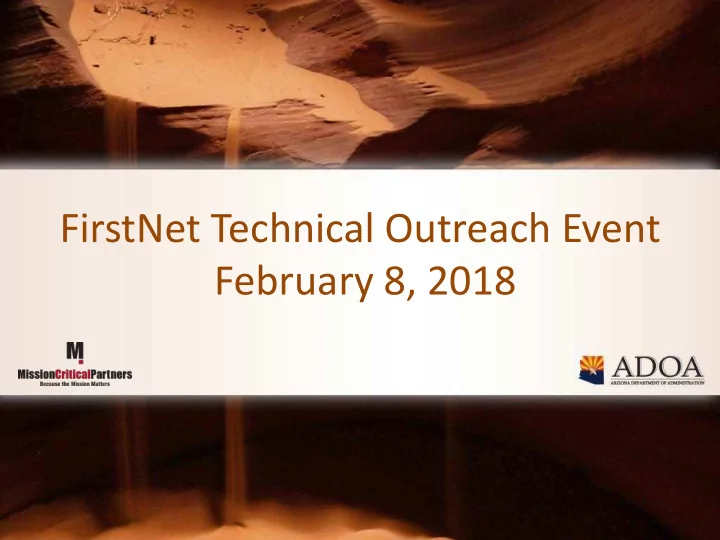

FirstNet Technical Outreach Event February 8, 2018
Click to edit Master title style PUBLIC SAFETY GRADE
Overview Public Safety Grade still a • controversial topic – vide recent statements from Verizon A NPSTC report from 2014 is • considered a common platform document In general, NPSTC report calls for • the FirstNet network and subscribers performance to meet or exceed that of high-end LMR systems and devices Additional documentation from • APCO is scheduled to be released as an ANSI standard during Spring of 2018
Major Categories in the NPSTC report • Environmental Events • Service Level Agreements • Reliability and Resiliency • Coverage • Push-To-Talk (PTT) • Applications • Site Hardening • Installation • Operations and Maintenance
Environmental Events • NPSTC completed a list of environmental risks known to have caused failures to public safety communications in the past • Each type of event is analyzed and recommendations are provided
Service Level Agreements • NPSTC compiled a list of components of a Public Safety Grade SLA document • The SLAs should specify coverage area, availability, reliability, resiliency, and other parameters to measure the services provided by the NPSBN • The recommendations include regular reporting and monetary penalties for non-compliance
Reliability and Resiliency • Reliability is the probability of the NPSBN completing its predefined function during a specified period of time. • Resiliency is the ability of the NPSBN to withstand a disruption to the network that would result in loss of coverage and the ability to recover from any such outage within a minimum period of time. • NPSTC conveyed the need for design choices that support a greater overall network reliability and resiliency to network disruptions compared to commercial networks, but did not provide any guidance as to how these should be measured. • One of the possible measures is the ability of service provider to remedy any problems within the time frame defined in SLA.
Coverage • Public Safety coverage needs are different from those of commercial operators: – Commercial networks: where the most demand for service is – Public Safety: desired 100 percent of the jurisdiction area • Critical buildings must be covered • Coverage performance definition needs to be verifiable • LTE coverage performance description needs to include parameters such as – User data rate – Traffic load level – Placement of radios/phones on the body of the user
Push-To-Talk (PTT) • NPSTC proposes detailed performance specifications and definitions that are necessary for mission critical public safety operations: • In general, PTT functionality and performance should be equal to or better than currently provided by LMR technologies • Update: The 3GPP standards completed in December ‘17
Applications • NPSTC’s paper covers the following areas: – Actionable information – Availability – Common data model – Human-centered interface – Interoperability – Operability – Performance – Resiliency – Scalability, adaptability, and portability – Security and information assurance – Updates – Verification and certification
Site Hardening • This section, provided by APCO, covers and provides detailed recommendations for the majority of all systems and infrastructure at a site: – Physical Security – Antenna Support Structure – Equipment Enclosures – Environmental and Climate Control – Power
Installation • This section defines a number of different detailed installation requirements covering: – Antenna Systems – Transmission Lines – Shelters, Equipment and Internal Cabling – Vehicles
Operations and Maintenance • Operations and maintenance practices focusing on prevention for RAN, backhaul, core, and sites : – Sites and Backhaul – Generators and UPS Maintenance
Q&A
Recommend
More recommend